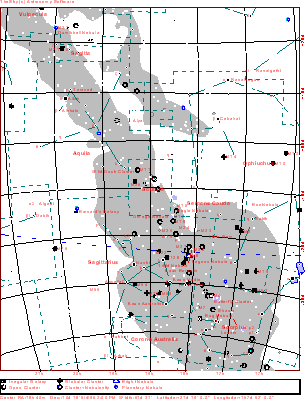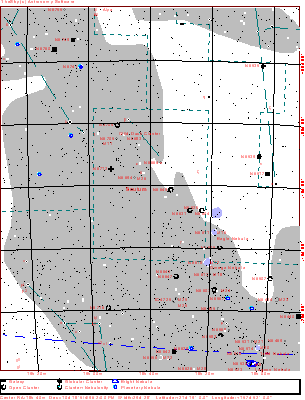
| Home | Deepsky Atlas | TheAstronews | Links | Solar System | ||||||

Hawaiian Astronomical SocietyConstellations: Scutum -- The Shield of a Polish King |
||||||||||

Click the map for a 916x1200 version of the above. Click here for a map better suited for use in the field.

This a more detailed view of the constellation. The map displays stars to magnitude 10, and deepsky objects to magnitude 12. Click here for a map better suited for use in the field.
 37k JPEG. NGC6712 (Bennett 117, Best 87) is a globular cluster located just south of the Scutum Star Cloud. Dreyer calls it fairly bright (mag. 8.2), very large (7.2'), irregular, and very gradually brightening a little toward the middle. Dreyer also gives it three Rs, meaning it is extremely resolvable. Whatever Dreyer may have thought, this particular cluster needs at least a 10" to resolve into stars. The cluster shines through a rich Milky Way field. 37k JPEG. NGC6712 (Bennett 117, Best 87) is a globular cluster located just south of the Scutum Star Cloud. Dreyer calls it fairly bright (mag. 8.2), very large (7.2'), irregular, and very gradually brightening a little toward the middle. Dreyer also gives it three Rs, meaning it is extremely resolvable. Whatever Dreyer may have thought, this particular cluster needs at least a 10" to resolve into stars. The cluster shines through a rich Milky Way field.
|
 91k JPEG. M11 (NGC6705, Bennett 116) is a lovely open cluster located in northeastern Scutum. Called the Wild Duck, because Admiral Smyth on a more sleep deprived night, thought the main body of the cluster resembled a flock of wild ducks, Dreyer described it as very bright (mag. 5.8), large (14'), irregular, rich with stars at about mag. 9. This cluster looks good in any scope. From the Digital Sky Survey. 91k JPEG. M11 (NGC6705, Bennett 116) is a lovely open cluster located in northeastern Scutum. Called the Wild Duck, because Admiral Smyth on a more sleep deprived night, thought the main body of the cluster resembled a flock of wild ducks, Dreyer described it as very bright (mag. 5.8), large (14'), irregular, rich with stars at about mag. 9. This cluster looks good in any scope. From the Digital Sky Survey.
M11 sits on the northern border of the Scutum Star Cloud. Extending over 4° of sky, the entire area rewards people with binoculars.
|
 88k JPEG. Barnard 318 is a dark nebula that snakes south and east of M11 for about 1.5°. The image from the Digital Sky Survey has been enhanced considerably to bring it out, but the object is fairly easy at low power. 88k JPEG. Barnard 318 is a dark nebula that snakes south and east of M11 for about 1.5°. The image from the Digital Sky Survey has been enhanced considerably to bring it out, but the object is fairly easy at low power.
|
 39k JPEG. M26 (NGC6694) is an open cluster located .8° E of the mag. 4.7 star Delta Scuti. At mag. 8 overall and 15' in size, Dreyer describes it as pretty rich, pretty condensed, with stars at mag. 12-15. The image is from SEDS. 39k JPEG. M26 (NGC6694) is an open cluster located .8° E of the mag. 4.7 star Delta Scuti. At mag. 8 overall and 15' in size, Dreyer describes it as pretty rich, pretty condensed, with stars at mag. 12-15. The image is from SEDS.
|
If you have any questions about the Hawaiian Astronomical Society
please
(link requires javascript).